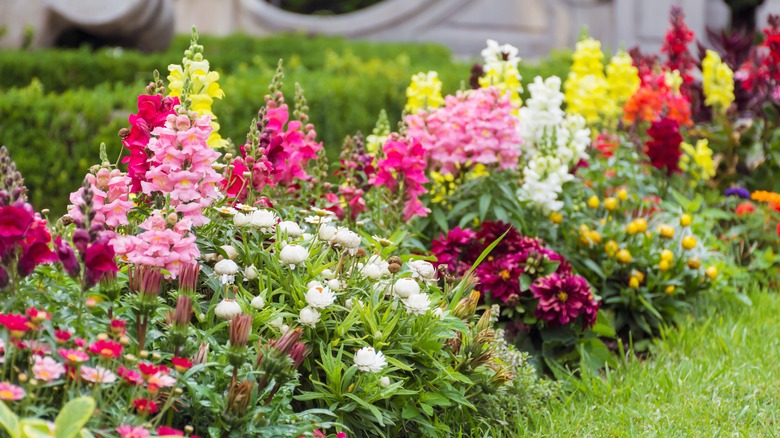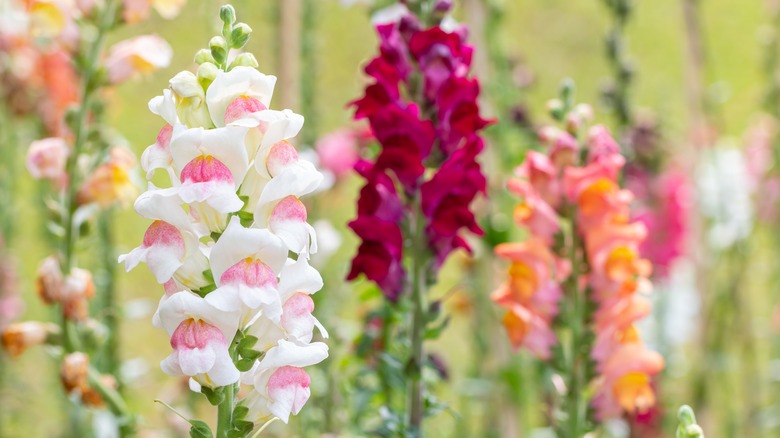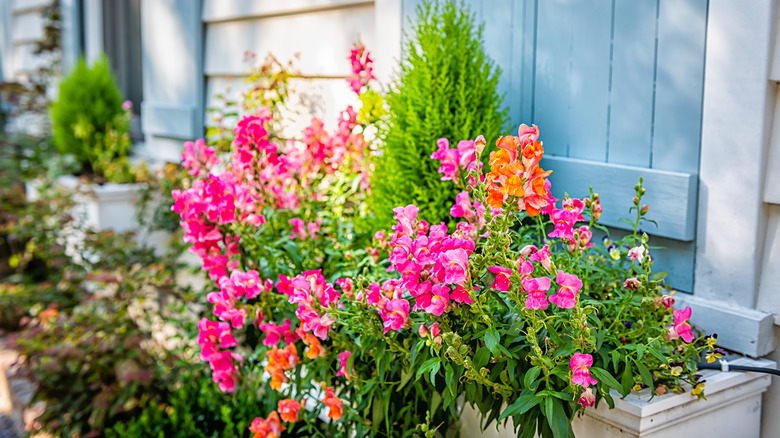This Is How To Achieve Vibrant Snapdragons All Autumn Long
Snapdragon flowers are a beloved garden favorite. They come in a wide assortment of colors, both solid and multi-colored, and their blooms are long lasting in both the garden and a vase. There are annual and perennial varieties: Perennial snapdragons tend to reseed the following year, and their stems can be taller and slightly more woody than annual snapdragons. Perennial snapdragons put on quite a show from summer through fall, and will even bloom after frost, but they do need some deadheading to continue to look their best.
Deadheading snapdragons is not quite as straightforward as deadheading other flowers. Normally, deadheading means removing spent blooms or stems that are no longer flowering. But perennial snapdragons follow a specific pattern of blooming. First, only one stem blooms, with buds usually opening along the entire length of the stem. Then, as those blooms begin to fade, that tall central stem starts to develop side stems which will eventually form new buds. Those side stem buds become the flowers that persist well into the autumn season, and even continue flowering after a hard frost. Therefore, it's important to deadhead your snapdragons properly to make sure you don't accidentally snip off the stems that are forming new buds. With the central stem removed, the plant can then devote more energy towards the emerging buds on the side stems.
Autumn blooming and seed formation
The side stems of your perennial snapdragons will start forming usually in early autumn. That's the time to trim back that central stem to give more space and energy to the emerging buds. If the central stem's flowers start to drop off or turn brown earlier, you can deadhead it as soon as it stops blooming. Use a pair of snips or pruning shears to make a clean cut.
As the snapdragon flowers start to dry out, they will leave behind small light brown seed pods that look a bit like tiny skulls. These seedpods contain tiny seeds that can be harvested and then replanted in spring, or scattered around nearby to reseed your snapdragons. If you want to harvest them, let some of your snapdragon stems form seedpods; they're more likely to do this if you leave the stem intact until the small brown seed heads form (as opposed to cutting the stem as soon as the flowers drop off).
You can harvest the dried seedpods without snipping off the stem if you wish — just pinch them off with your fingers. Let the seedpods continue to dry in a bowl for a few days until you can hear the tiny seeds rattling around inside; this means they are dry and can be removed from the seedpod. Then you can save them for spring planting.
Where to plant snapdragons for maximum fall beauty
Placement of your perennial snapdragons is something to consider if you want to make the most of their long bloom season. Tall snapdragons are visible in the middle of the garden bed, but when that central stem is cut back to make room for side stems, the flower loses considerable height. Also, your snapdragon will likely bend over and the flowering stems on the sides of the central stem tend to bloom sideways instead of shooting straight up.
To make the most of these shifts in shape of your snapdragons as the season proceeds, plant some of them in spots where the flowers will be visible from a lower angle. Putting a few perennial snapdragons at the front of the garden bed will provide some colorful blooms in late autumn when many other perennials have faded. They may also reseed and give you new snapdragons in spring. Snapdragons are particularly nice planted along a walkway where you'll see them often and enjoy their vivid colors.
It's also a good idea to add some perennial snapdragons to your container gardens. The tall blooming spikes add drama and plenty of color in the summer. Then, as autumn arrives, those side-blooming stems will still provide some color and interest in your container, even as you switch out your lobelia for mums, or make other seasonal changes.


